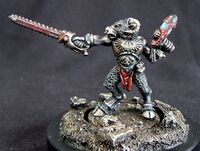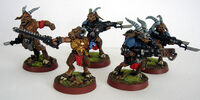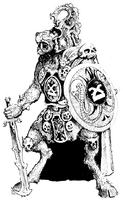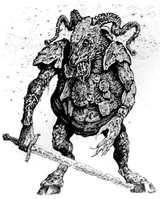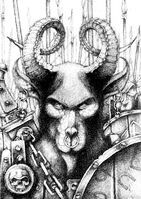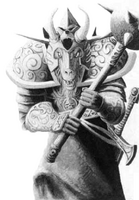No edit summary Tag: rte-source |
m (→Turnskin) Tag: sourceedit |
||
| Line 51: | Line 51: | ||
===Turnskin=== |
===Turnskin=== |
||
| − | A Turnskin is a Beastman who was born human. The continual rate of mutation amongst the human population throughout the galaxy often results in hideous mutations. Human [[mutants]] are not tolerated in their own societies, and most of them are killed when their mutations manifest themselves, or are driven from their homes to die lonely deaths. The toughest and most cunning manage to survive their physical and psychological rejection and come to join up with bands of Beastmen. Regardless of their physical appearance, a Turnskin is always a Turnskin rather than a "pure" Beastman, which means he is the lowest of the low as far as the Beastmen are concerned. If a Turnskin has horns, they are sawed off before he can be accepted by other Beastmen |
+ | A Turnskin is a Beastman who was born human. The continual rate of mutation amongst the human population throughout the galaxy often results in hideous mutations. Human [[mutants]] are not tolerated in their own societies, and most of them are killed when their mutations manifest themselves, or are driven from their homes to die lonely deaths. The toughest and most cunning manage to survive their physical and psychological rejection and come to join up with bands of Beastmen. Regardless of their physical appearance, a Turnskin is always a Turnskin rather than a "pure" Beastman, which means he is the lowest of the low as far as the Beastmen are concerned. If a Turnskin has horns, they are sawed off before he can be accepted by other Beastmen; otherwise, he could be mistaken for a Gor. |
===Gaves=== |
===Gaves=== |
||
Revision as of 14:44, 5 December 2016
Note: This article discusses material that was once considered canon but whose canonicity is now questionable.
"Beastman bad. Bad Beastman. Dirty. Emperor no like. Beastman love Emperor. Give blood to Emperor. Give heads to Emperor. Say sorry."
- — Packmaster Grasht, attached to the 7th Company, 14th Gratanor Regiment, Imperialis Auxilia during the Great Crusade
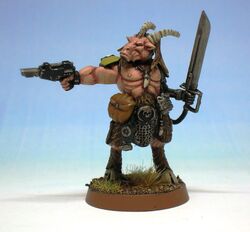
A typical Beastman armed with a Laspistol and Power Sword in service to the Imperial Army during the Great Crusade
Beastmen (sing. Beastman) (Homo sapiens variatus) are Abhumans descended from human stock who combine the physical appearances of humans and Terran animals, usually goats or rams. Beastmen do not necessarily look alike, and different animal traits can manifest themselves in each individual, but apart from this form of phenotypical variation they are a genetically stable human subspecies, and are considered to be a form of Abhuman rather than an actual mutant. The origin of Beastmen is unknown, though it is likely that they are the result of experiments in genetic engineering stretching back to the Dark Age of Technology before the birth of the Imperium of Man, who proceeded to breed true. Other Imperial savants claim that Beastmen are Abhumans whose unusual forms were the result of exposure to the influence of the Warp but that the subspecies somehow managed to maintain an unusual degree of genetic stability across generations.
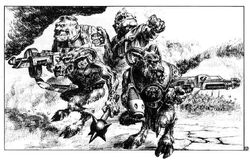
A pair of Beastmen fighting alongside Ogryns during the Great Crusade
In temperament as well as appearance these Abhumans are often bestial, and possess a reputation for crudity, aggression and bad discipline. Starting in the late 30th Millennium, Beastmen were often recruited into the ranks of the Imperial Army as part of the massive galactic expansion of the burgeoning Imperium of Man during the Great Crusade, which began after circa 800.M30. Beastmen in the Imperial Army were regarded as useful if highly undisciplined warriors, and were ideal for suicidal assaults where brawn rather than tactical intellect was required. Other Imperial troops disliked them intently as they were quite rowdy, unsanitary and generally unpleasant for baseline humans to deal with. Following the events of the galaxy-wide civil war known as the Horus Heresy, and the subsequent restructuring of the Imperial armed forces by the Ultramarines Legion Primarch Roboute Guilliman according to the dictats of his magnum opus, the Codex Astartes, Beastmen regiments were retained in the newborn Imperial Guard, where they were often led by the largest and most powerful of their kind, known as Packmasters.
Those Beastmen who have been introduced to the Imperial Cult by the missionaries of the Adeptus Ministorum possess a simple but fierce devotion to the Emperor of Mankind and regard Him as a vengeful god who demands tribute in the form of the blood of His enemies. These fanatically religious Beastmen are driven by the need to atone for their original sin of being mutants by fighting in service to the Emperor.
In recent centuries there has been a political shift within the Imperium and Beastmen are no longer seen in Imperial military service; no doubt the more Puritan elements of the Inquisition convinced the Departmento Munitorum that Beastmen could not be so radically different from the genetic human baseline without having been in some way affected by the taint of Chaos. In the late 41st Millennium, Beastmen are often now classified as mutants and as a result are the subject of severe Imperial persecution and have been placed on the Register of Proscribed Citizens (Class A-G worlds) by the Adeptus Arbites. This effectively precludes them from settlement on, or transportation to or from, more than three hundred thousand worlds of the Imperium and forbids their conscription as an Imperial Tithe obligation. All of this is a sure sign that they will soon lose Abhuman status completely and be reclassified as true mutants. These creatures are often hunted down during anti-mutant pogroms conducted by the Adeptus Arbites on those worlds where populations of Beastmen are known to exist. This persecution, of course, has led many Beastmen to seek protection in the service of Chaos, thus in effect producing a self-fulfilling prophecy.
Chaotic Beastmen
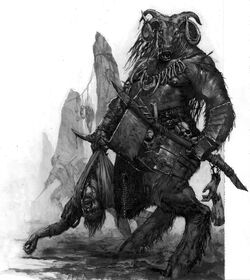
A Chaos Beastman with his unfortunate human victim during a raid on a human settlement
Beastmen are destined to become the outcasts of Imperial society. They are shunned and are often hunted down and killed as the Imperium has little tolerance for any who deviate from the perfection of the baseline human form in mind or body. Mutation is considered a heretical crime against the Emperor of Mankind by Imperial authorities because of its connection to sympathy or worship of Chaos. As creatures of the Warp, these beastial warriors often fall to the service of Chaos as a means of escaping the persecution of Imperial society or are lulled into the service of the one of the four Chaos Gods due to their inherent nature as creatures of Chaos. The Ruinous Powers look upon Beastmen with special favour, and Chaotic "gifts" are often granted to those Beastmen who become Champions of Chaos even though they may serve no specific Chaos God. Champions who do follow Khorne, Nurgle, Slaanesh or Tzeentch often benefit from the relationship more readily than human or other Chaos Champions, because they are closer to the true nature of Chaos.
Bloodgors, Beastmen of Khorne
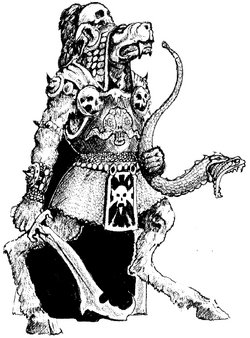
A Bloodgor Beastman
Those Beastmen who serve the Blood God Khorne are known as Bloodgors or Khorngors. The signature of Khorne is writ clearly upon the form of the Blood God's Beastmen. They have canine heads or faces, fierce snapping jaws, and teeth which drip with rank saliva. Their skin or fur is usually red and their eyes are all white with red pupils. Khorngor Champions often have fur which is especially impressive, either bright red, black with red flecks, or a strange metallic brassy colour. If the Beastmen has horns these may be twisted into the shape of the skull-like rune known as the Mark of Khorne. The same rune is often painted or burned onto their skin or fur, and can be tattooed onto their exposed foreheads. Beastmen of Khorne always fight in their own units, although they can be led by a Beastman Champion so long as he does not follow any other Chaos God.
These foul creatures, enslaved to the worship of Khorne, populate many planets within the Eye of Terror. Dim-witted, cruel, unruly and easily startled, they are always keen to kill for their masters -- who are careless of their lives, sending Packmasters to whip them towards the enemy's guns.
Beastmen of Khorne hate enemies who are mortal followers of Slaanesh, including Beastmen who follow that patron. They also hate all enemy Chaos Sorcerers. They do not hate enemy Shamans who also follow Khorne, as they cannot cast sorcerous spells but have the power to nullify psychic abilities. Their hatred only applies to enemy troops, never to allies, even if they are followers of another Ruinous Power.
Pestigors, Beastmen of Nurgle
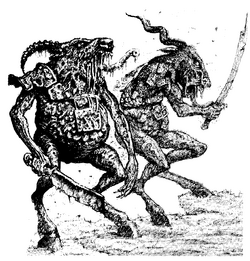
A pair of Pestigor Beastmen
The Pestigors, the Beastmen of Nurgle, have blistered and broken skins, often red with cracked flesh and sores which have been given to them by a generous master. Their fur is matted and coarse, and their bodies are riddled with all kinds of disease. Yet they retain the morbid vigour that characterises their master so their afflictions in no way mar their battle-worthiness. The Mark of Nurgle is carved into their armour, daubed upon their clothes, and sometimes etched onto their skin by the path of disfiguring disease. Many Beastmen of Nurgle carry Nurgle's Rot, although thanks to their loyalty to Grandfather Nurgle, that terrible arcane disease will not affect them.
Slaangors, Beastmen of Slaanesh
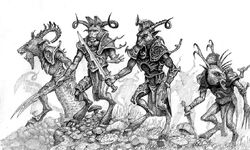
A pack of Slaangor Beastmen
Beastmen of the Chaos God Slaanesh, known as Slaangors, have white or near white fur and pale or pastel skins. Their eyes are green and are sometimes saucer-like in a similar way to those of the Daemonettes. The Mark of Slaanesh appears somewhere on them, painted onto their hides or carved into their armour, a bracelet or neck collar. Many of Slaanesh's Beastmen have the head or horns of a bull (known as Bovigors) just like the Greater Daemon of their patron god.
Tzaangors, Beastmen of Tzeentch

A Tzaangor Beastman
True to the Changer of the Ways, Beastmen of Tzeentch, known as Tzaangors, are spectacularly variable. They always have at least one outstanding feature, either brightly coloured or exotically patterned fur, or very impressively coloured or shaped horns. Other mutations are commonplace amongst Tzaangors. Where other Beastmen often have no mutations (beyond their already altered phenotype), Beastmen of Tzeentch always have at least one.
Other Beastmen Species
To the fearful eyes of humanity all Beastmen appear the same -- an unruly mass of flesh, fur and teeth. In their ignorance they can discern no distinguishing characteristics that mark the different physical and social types, nor any kind of social hierarchy apart from the simple supremacy of the strongest. This is a mistake often made by humans, whose judgement of Beastmen is overwhelmed by the brutal power and savagery of these creatures. In fact, Beastmen society is very precise and ordered, and there are several distinct levels of class and rank.
Gors

A pack of savage Gors launching a raid against a human settlement
The most common type of Beastmen are called Gors, who can be readily distinguished from more lowly breeds by their horns. The number of horns is not important, although it is preferable that they should be on the creature's head. Gors take great pride in their horns and often polish, paint or decorate them to enhance their natural lustre or shape. Lowly breeds look to the Gors for guidance and leadership, praising them endlessly in victory, and grumbling behind their backs when things are not going so well. Most Beastmen battle-leaders and the top warriors will be Gors. Gors are divided into two main types and a less common third type. The two main types are the goat-horned Caprigors and the bull-horned Bovigors. The third variety is known as the Ungor, a Beastmen phrase which means something akin to, "not quite right Gors" or "no-horns".
- Caprigors - The most common type of Gor. They have curling or straight horns on their head like a goat or sheep. A Caprigor may have the entire head of a goat and often has goat's legs as well. A Beastman with these mutations but no others is called a Truegor. This title is also shared by some other kinds of Gor. A Caprigor Truegor is said to be bigger, braver and even more clever than other Caprigors.
- Bovigors - Not quite as numerous as Caprigors, a Bovigor bears cattle horns on his head and may have the entire head of a bull or an ox. If he has a bull's head and either human or goat legs he is a Truegor. Bovigors are very competitive and like to think they are superior to other Gors. Most Bovigors believe that brawn is better than brains, and many possess a great deal of the former and very little of the latter.
- Ungors - Ungors are not as strong or robust of frame as the Gors, but they more than make up for it in sheer malevolence. They are physically smaller than other Beastmen and their horns, if they have any at all, are less impressive and less numerous. While Gors may have long and spectacular horns as deadly as any sword, Ungors usually have short prongs or horn buds sprouting from their skulls, not recognisable as those of a goat or any other type acknowledged by the Gors. As a result they are not considered to be "proper" Beastmen by other Gors. The race of Mankind, on the other hand, does not draw such distinctions. To them the Ungors are just as horrible, horns or no, for they are all twisted abberations of nature that live to murder and despoil all that is good and wholesome.
Bray
The majority of Beastmen who are not Gors are called Bray. The name refers to the braying, whinnying, whooping cacophony that Beastmen make when they band together to fight or feast. Apart from lacking horns, there is very little consistency in appearance that distinguishes a Bray from a Gor. A very brave, cunning, and unusually lucky Bray can rise to become a leader, but this is not very common. Gors do not like Brays giving them orders, and a Bray who fails to show a Gor the proper respect is asking for trouble.
Spawn
The dividing line between a mutant and Chaos Spawn is a narrow one. Amongst Beastmen it is a line that is often crossed. As with all of the followers of Chaos, fresh mutations can turn them into Chaos Spawn: mindless and unrecognisable things divested of their intellect and form. Sometimes Spawn are killed or driven away if they are dangerous or useless. But Spawn who are helpful, perhaps because they are still worthwhile fighters, are kept out of respect for the mighty warriors they once were.
Turnskin
A Turnskin is a Beastman who was born human. The continual rate of mutation amongst the human population throughout the galaxy often results in hideous mutations. Human mutants are not tolerated in their own societies, and most of them are killed when their mutations manifest themselves, or are driven from their homes to die lonely deaths. The toughest and most cunning manage to survive their physical and psychological rejection and come to join up with bands of Beastmen. Regardless of their physical appearance, a Turnskin is always a Turnskin rather than a "pure" Beastman, which means he is the lowest of the low as far as the Beastmen are concerned. If a Turnskin has horns, they are sawed off before he can be accepted by other Beastmen; otherwise, he could be mistaken for a Gor.
Gaves
Throughout the many worlds, it is not uncommon that healthy, sound human parents produce a mutant child. While some mothers try to conceal their babe's deformities, the majority feel such shame that they give them up to the forests or rivers. Left amongst a bed of fallen leaves or set afloat upon a raft of reeds, the newborn mutants are abandoned to die from exposure and hunger. But they rarely die, for the ears of the Beastmen are keen, and they are always alert to the cries of their own kind. Such foundlings are adopted and reared in the forests in the deepest and most permanent camps of the Beastmen. They are called "Gaves" or "Gave Children." The Beastmen regard them as a gift of Chaos and welcome them amongst their ranks. Gaves grow into Beastmen and become Gors, Brays or the other types described depending on their appearance. Beastmen place no stigma on Gaves, and sometimes add the suufix "gave" to their name if they are adopted foundlings of this kind. Horngave, Gorgave, Shadowgave and Nightgave are typical Gave names.
Shaman
Shamans are a very special kind of Beastmen because they possess psychic powers. However, this fact alone is only a part of what makes them special. Shamans are the intermediaries between the Beastmen and the Realm of Chaos itself. They can spirit-walk in the Empyrean and talk with the very daemons of the Chaos Gods. Shamans never lead other Beastmen, but the Beastmen's strongest leaders rely on them for all kinds of advice as well as sorcerous aid in battle.
Minotaurs
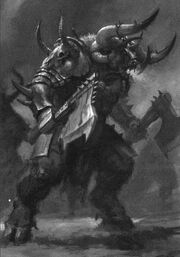
A Minotaur warrior
An unusually large and aggressive strain of giant Beastman, Minotaurs are comparable in physical size and strength to an Ogryn. These creatures are massive, bull-headed monstrosities that constantly hunger for hot blood and red meat. Often growing to twice the height of a man and far greater in muscular bulk, their thick-skulled heads are broad and ugly, and their horns can eviscerate with a single thrust. Minotaurs are possessed of a terrible hunger for flesh, particularly the flesh of Mankind. Yet it is not the gnawing hunger a mortal feels when deprived of sustenance, but a deep thirst for the unholy exhilaration the Minotaurs experience when they consume the flesh of their enemies. In this state they join with the power of the Chaos Gods and share in part of their unholy glory.
Trivia
Beastmen were initially part of Warhammer 40,000: Rogue Trader First Edition's Imperial Guard armies. They could later be used in Imperial Guard armies with the use of the Homo Sapiens Variatus Doctrine, and in the army list for the The Lost and the Damned, though these rules are now obsolete and Beastmen are not officially included in any of the current Imperial or Chaos armies. The Beastmen were originally part of the Warhammer 40,000 universe because, like many of the other factions, they were direct ports of Warhammer Fantasy 's Beastmen. On Warhammer Fantasy's Warhammer World, the Beastmen are mutants born as the result of Chaotic influence upon their parents. In later editions of the game, Games Workshop has sought to take the Warhammer 40,000 universe farther away from its Warhammer Fantasy roots and create more distance between both intellectual properties; the same impulse was responsible for the removal of the Squats as a playable race in the Warhammer 40,000 universe because Games Workshop no longer felt that a species of "Space Dwarfs" was appropriate for their science fiction universe.
See Also
Sources
- Codex: Eye of Terror (3rd Edition)
- Codex Imperialis (1st Edition), pg. 89
- Imperial Armour Volume Six - The Siege of Vraks - Part Two, pg. 135
- Realm of Chaos: The Lost and the Damned, pg. 137-141, 201
- Warhammer 40,000: Compendium (2nd Edition), "The Imperial Guard" pp. 49, 148, 152
- Warhammer 40,000: Rogue Trader (1st Edition), pg. 174
- Warhammer 40,000: Rulebook (6th Edition), pp. 404-405
- White Dwarf 124 (UK), "Beastmen", pp. 60-73

